2016 California Standards for Accessible Design Pocket Guide - Eff. Jan. 1, 2017
11B-407 Elevators.
11B-407.1 General.
Elevators shall comply with Section 11B-407 and with ASME A17.1. They shall be passenger elevators as classified by ASME A17.1. Elevator operation shall be automatic.
[2010 ADAS] Advisory 407.1 General. The ADA and other Federal civil rights laws require that accessible features be maintained in working order so that they are accessible to and usable by those people they are intended to benefit. Building owners should note that the ASME Safety Code for Elevators and Escalators requires routine maintenance and inspections. Isolated or temporary interruptions in service due to maintenance or repairs may be unavoidable; however, failure to take prompt action to effect repairs could constitute a violation of Federal laws and these requirements.
DSA regulates the usability of elevators and platform (wheelchair) lifts for persons with disabilities. Accessibility scoping requirements for elevators and lifts are located in Sections 11B-206.6 and 11B-206.7; technical requirements are located in Sections 11B-407, 11B-408, 11B-409 and 11B-410.◼
11B-407.1.1 Combined passenger and freight elevators.
When the only elevators provided for use by the public and employees are combination passenger and freight elevators, they shall comply with Section 11B-407 and with ASME A17.1.
11B-407.2 Elevator landing requirements.
Elevator landings shall comply with Section 11B-407.2.
11B-407.2.1 Call controls.
Where elevator call buttons or keypads are provided, they shall comply with Sections 11B-407.2.1 and 11B-309.4 _|Operation|_.
[2010 ADAS] 407.2.1 Call Controls. Where elevator call buttons or keypads are provided, they shall comply with 407.2.1 and 309.4. Call buttons shall be raised or flush.
Exception: Reserved.
[2010 ADAS] EXCEPTION: Existing elevators shall be permitted to have recessed call buttons.
11B-407.2.1.1 Height.
Call buttons and keypads shall be located within one of the reach ranges specified in Section 11B-308, measured to the centerline of the highest operable part.
Exception: Reserved.
[2010 ADAS] EXCEPTION: Existing call buttons and existing keypads shall be permitted to be located at 54 inches (1370 mm) maximum above the finish floor, measured to the centerline of the highest operable part.
11B-407.2.1.2 Size and shape.
Call buttons shall have square shoulders, be ¾ inch (19.1 mm) minimum in the smallest dimension and shall be raised 1/8 inch (3.2 mm) plus or minus 1/32 inch (0.8 mm) above the surrounding surface. The buttons shall be activated by a mechanical motion that is detectable.
[2010 ADAS] 407.2.1.2 Size. Call buttons shall be ¾ inch (19 mm) minimum in the smallest dimension.
Exception: Reserved.
[2010 ADAS] EXCEPTION: Existing elevator call buttons shall not be required to comply with 407.2.1.2.
11B-407.2.1.3 Clear floor or ground space.
A clear floor or ground space complying with Section 11B-305 shall be provided at call controls.
[2010 ADAS] Advisory 407.2.1.3 Clear Floor or Ground Space. The clear floor or ground space required at elevator call buttons must remain free of obstructions including ashtrays, plants, and other decorative elements that prevent wheelchair users and others from reaching the call buttons. The height of the clear floor or ground space is considered to be a volume from the floor to 80 inches (2030 mm) above the floor. Recessed ashtrays should not be placed near elevator call buttons so that persons who are blind or visually impaired do not inadvertently contact them or their contents as they reach for the call buttons.
11B-407.2.1.4 Location.
The call button that designates the up direction shall be located above the call button that designates the down direction.
Exception: Reserved.
[2010 ADAS] Advisory 407.2.1.4 Location Exception. A destination-oriented elevator system provides lobby controls enabling passengers to select floor stops, lobby indicators designating which elevator to use, and a car indicator designating the floors at which the car will stop. Responding cars are programmed for maximum efficiency by reducing the number of stops any passenger experiences.
11B-407.2.1.5 Signals.
Call buttons shall have visible signals that will activate when each call is registered and will extinguish when each call is answered. Call buttons shall be internally illuminated with a white light over the entire surface of the button.
[2010 ADAS] 407.2.1.5 Signals. Call buttons shall have visible signals to indicate when each call is registered and when each call is answered.
Exceptions:
1. Reserved.
2. Reserved.
[2010 ADAS] 2. Existing elevators shall not be required to comply with 407.2.1.5.
11B-407.2.1.6 Keypads.
Where keypads are provided, keypads shall be in a standard telephone keypad arrangement and shall comply with Section 11B-407.4.7.2.
ETA Editor's Note
Lacking certain Exceptions allowed by 2010 ADAS, and imposing additional requirements regarding call buttons, the preceding CBC requirements pertaining to elevator call controls are more stringent than 2010 ADAS.
11B-407.2.2 Hall signals.
Hall signals, including in-car signals, shall comply with Section 11B-407.2.2.
11B-407.2.2.1 Visible and audible signals.
A visible and audible signal shall be provided at each hoistway entrance to indicate which car is answering a call and the car’s direction of travel. Where in-car signals are provided, they shall be visible from the floor area adjacent to the hall call buttons.
Exceptions:
1. Reserved.
2. Reserved.
[2010 ADAS] 2. In existing elevators, a signal indicating the direction of car travel shall not be required.
11B-407.2.2.2 Visible signals.
Visible signal fixtures shall be centered at 72 inches (1829 mm) minimum above the finish floor or ground. The visible signal elements shall be a minimum 2½ inches (64 mm) high by 2½ inches (64 mm) wide. Signals shall be visible from the floor area adjacent to the hall call button.
Exceptions:
1. Reserved.
2. Reserved.
[2010 ADAS] 2. Existing elevators shall not be required to comply with 407.2.2.2.
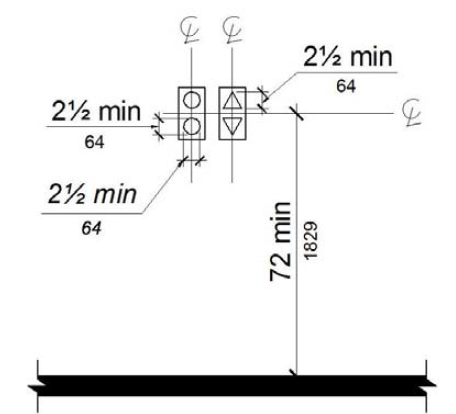
FIGURE 11B-407.2.2.2 ‡‡
VISIBLE HALL SIGNALS
11B-407.2.2.3 Audible signals.
Audible signals shall sound once for the up direction and twice for the down direction, or shall have verbal annunciators that indicate the direction of elevator car travel. Audible signals shall have a frequency of 1500 Hz maximum. Verbal annunciators shall have a frequency of 300 Hz minimum and 3000 Hz maximum. The audible signal and verbal annunciator shall be 10 dB minimum above ambient, but shall not exceed 80 dB, measured at the hall call button.
Exceptions:
1. Reserved.
2. Reserved.
[2010 ADAS] 2. Existing elevators shall not be required to comply with the requirements for frequency and dB range of audible signals.
11B-407.2.2.4 Differentiation.
Reserved.
ETA Editor's Note
Lacking certain Exceptions allowed by 2010 ADAS, and imposing additional requirements regarding visible signals, the preceding CBC requirements pertaining to elevator hall signals are more stringent than 2010 ADAS.
11B-407.2.3 Hoistway signs.
Signs at elevator hoistways shall comply with Section 11B-407.2.3.
11B-407.2.3.1 Floor designation.
Floor designations complying with Sections 11B-703.2 and 11B-703.4.1 shall be provided on both jambs of elevator hoistway entrances. Floor designations shall be provided in both raised characters and braille. Raised characters shall be 2 inches (51 mm) high. A raised star, placed to the left of the floor designation, shall be provided on both jambs at the main entry level. The outside diameter of the star shall be 2 inches (51 mm) and all points shall be of equal length. Raised characters, including the star, shall be white on a black background. Braille complying with Section 11B-703.3 shall be placed below the corresponding raised characters and the star. The Braille translation for the star shall be “MAIN”. Applied plates are acceptable if they are permanently fixed to the jamb.
[2010 ADAS] 407.2.3.1 Floor Designation. Floor designations complying with 703.2 and 703.4.1 shall be provided on both jambs of elevator hoistway entrances. Floor designations shall be provided in both tactile characters and braille. Tactile characters shall be 2 inches (51 mm) high minimum. A tactile star shall be provided on both jambs at the main entry level.
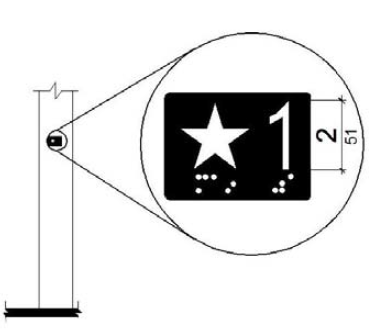
FIGURE 11B-407.2.3.1 ‡‡
FLOOR DESIGNATIONS ON JAMBS OF ELEVATOR HOISTWAY ENTRANCES
11B-407.2.3.2 Reserved.
ETA Editor's Note
Imposing additional requirements regarding characters and colors, the preceding CBC requirements pertaining to elevator hoistway signs are more stringent than 2010 ADAS.
11B-407.3 Elevator door requirements.
Hoistway and car doors shall comply with Section 11B-407.3.
11B-407.3.1 Type.
Elevator doors shall be the horizontal sliding type. Car gates shall be prohibited.
11B-407.3.2 Operation.
Elevator hoistway and car doors shall open and close automatically.
Exception: Existing manually operated hoistway swing doors shall be permitted provided that they comply with Sections 11B-404.2.3 and 11B-404.2.9. Car door closing shall not be initiated until the hoistway door is closed.
11B-407.3.3 Reopening device.
Elevator doors shall be provided with a reopening device complying with Section 11B-407.3.3 that shall stop and reopen a car door and hoistway door automatically if the door becomes obstructed by an object or person.
Exception: Existing elevators with manually operated doors shall not be required to comply with Section 11B-407.3.3.
11B-407.3.3.1 Height.
The device shall be activated by sensing an obstruction passing through the opening at 5 inches (127 mm) nominal and 29 inches (737 mm) nominal above the finish floor.
11B-407.3.3.2 Contact.
The device shall not require physical contact to be activated, although contact is permitted to occur before the door reverses.
11B-407.3.3.3 Duration.
Door reopening devices shall remain effective for 20 seconds minimum.
11B-407.3.4 Door and signal timing.
The minimum acceptable time from notification that a car is answering a call until the doors of that car start to close shall be calculated from the following equation:
T = D/(1.5 ft/s) or T = D/(457 mm/s) = 5 seconds minimum where T equals the total time in seconds and D equals the distance (in feet or millimeters) from the point in the lobby or corridor 60 inches (1524 mm) directly in front of the farthest call button controlling that car to the centerline of its hoistway door.
Exceptions:
1. For cars with in-car lanterns, T shall be permitted to begin when the signal is visible from the point 60 inches (1524 mm) directly in front of the farthest hall call button and the audible signal is sounded.
2. Reserved.
11B-407.3.5 Door delay.
Elevator doors shall remain fully open in response to a car call for 5 seconds minimum.
[2010 ADAS] 407.3.5 Door Delay. Elevator doors shall remain fully open in response to a car call for 3 seconds minimum.
11B-407.3.6 Width.
The width of elevator doors shall comply with Table 11B-407.4.1.
Exception: In existing elevators, a power-operated car door complying with Section 11B-404.2.3 shall be permitted.
11B-407.4 Elevator car requirements.
Elevator cars shall comply with Section 11B-407.4.
11B-407.4.1 Car dimensions.
Inside dimensions of elevator cars and clear width of elevator doors shall comply with Table 11B-407.4.1.
Exception: In existing buildings, where existing shaft configuration prohibits strict compliance with Section 11B-407.4.1, existing elevator car configurations that provide a clear floor area of 18 square feet (1.67 m2) minimum and also provide an inside clear depth 54 inches (1372 mm) minimum and a clear width 48 inches (1219 mm) minimum shall be permitted.
[2010 ADAS] EXCEPTION: Existing elevator car configurations that provide a clear floor area of 16 square feet (1.5 m2) minimum and also provide an inside clear depth 54 inches (1370 mm) minimum and a clear width 36 inches (915 mm) minimum shall be permitted.
ETA Editor's Note
The CBC Exception at 11B-407.4.1 is more stringent than that of 2010 ADAS regarding minimum car dimensions for existing elevators.
TABLE 11B-407.4.1 ELEVATOR CAR DIMENSIONS
|
MINIMUM DIMENSIONS |
||||
|---|---|---|---|---|
|
Door Location |
Door clear width |
Inside car, side to side |
Inside car, back wall to front return |
Inside car, back wall to inside face of door |
|
Centered |
42 inches (1067 mm) |
80 inches (2032 mm) |
51 inches (1295 mm) |
54 inches (1372 mm) |
|
Side (off-centered) |
36 inches (914 mm)1 |
68 inches (1727 mm) |
51 inches (1295 mm) |
54 inches (1372 mm) |
|
Any |
36 inches (914 mm)1 |
54 inches (1372 mm) |
80 inches (2032 mm) |
80 inches (2032 mm) |
|
Any |
36 inches (914 mm)2 |
60 inches (1524 mm)2 |
60 inches (1524 mm)2 |
60 inches (1524 mm)2 |
|
1. A tolerance of minus 5/8 inch (15.9 mm) is permitted. 2. Other car configurations that provide a turning space complying with Section 11B-304 with the door closed shall be permitted. |
||||
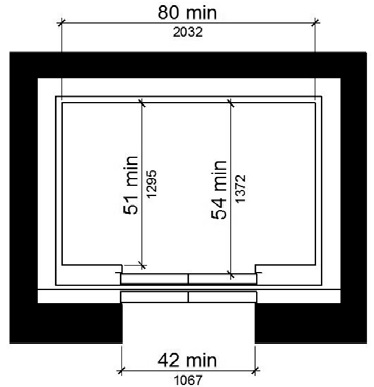
(a)
centered door
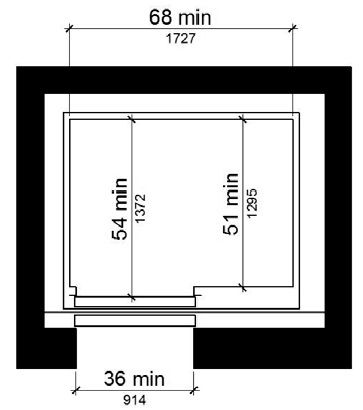
(b)
side (off-centered) door
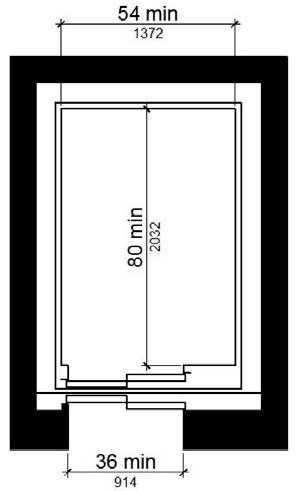
(c)
any door location
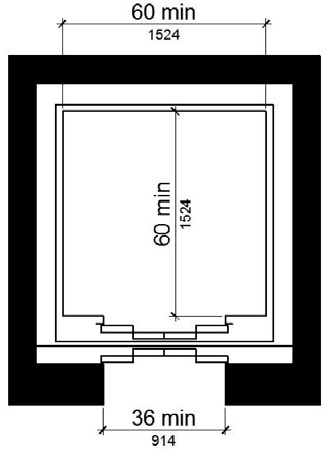
(d)
any door location
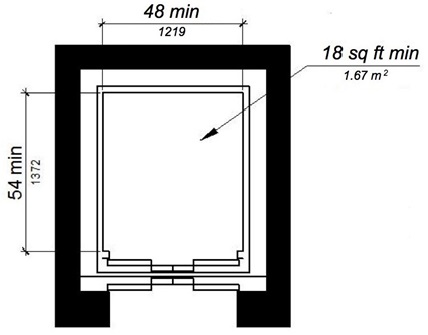
(e)
Exception existing elevator car configuration
FIGURE 11B-407.4.1 ‡‡
ELEVATOR CAR DIMENSIONS
11B-407.4.2 Floor surfaces.
Floor surfaces in elevator cars shall comply with Section 11B-302 and 11B-303.
11B-407.4.3 Platform to hoistway clearance.
The clearance between the car platform sill and the edge of any hoistway landing shall be 1¼ inch (32 mm) maximum.
11B-407.4.4 Leveling.
Each car shall be equipped with a self-leveling feature that will automatically bring and maintain the car at floor landings within a tolerance of ½ inch (12.7 mm) under rated loading to zero loading conditions.
11B-407.4.5 Illumination.
The level of illumination at the car controls, platform, car threshold and car landing sill shall be 5 foot candles (54 lux) minimum.
11B-407.4.6 Elevator car controls.
Where provided, elevator car controls shall comply with Sections 11B-407.4.6 and 11B-309.4 _|Operation|_.
Exception: In existing elevators, where a new car operating panel complying with Section 11B-407.4.6 is provided, existing car operating panels may remain operational and shall not be required to comply with Section 11B-407.4.6.
11B-407.4.6.1 Location.
Controls shall be located within one of the reach ranges specified in Section 11B-308.
Exceptions:
1. Where the elevator panel serves more than 16 openings and a parallel approach is provided, buttons with floor designations shall be permitted to be 54 inches (1372 mm) maximum above the finish floor.
2. In existing elevators, car control buttons with floor designations shall be permitted to be located 54 inches (1372 mm) maximum above the finish floor where a parallel approach is provided.
11B-407.4.6.2 Buttons.
Car control buttons with floor designations shall comply with Section 11B-407.4.6.2.
Exception: Reserved.
[2010 ADAS] EXCEPTION: In existing elevators, buttons shall be permitted to be recessed.
11B-407.4.6.2.1 Size and shape. Buttons shall have square shoulders, be ¾ inch (19.1 mm) minimum in their smallest dimension and be raised 1/8 inch (3.2 mm) plus or minus 1/32 inch (0.8 mm) above the surrounding surface.
[2010 ADAS] 407.4.6.2.1 Size. Buttons shall be ¾ inch (19 mm) minimum in their smallest dimension.
11B-407.4.6.2.2 Arrangement.
Buttons shall be arranged with numbers in ascending order. When two or more columns of buttons are provided they shall read from left to right.
11B-407.4.6.2.3 Illumination.
Car control buttons shall be illuminated.
11B-407.4.6.2.4 Operation.
Car control buttons shall be activated by a mechanical motion that is detectable.
11B-407.4.6.3 Keypads.
Car control keypads shall be in a standard telephone keypad arrangement and shall comply with Section 11B-407.4.7.2.
11B-407.4.6.4 Emergency controls.
Emergency controls shall comply with Section 11B-407.4.6.4.
11B-407.4.6.4.1 Height.
Emergency control buttons shall have their centerlines 35 inches (889 mm) minimum above the finish floor.
11B-407.4.6.4.2 Location.
Emergency controls, including the emergency alarm, shall be grouped at the bottom of the panel.
11B-407.4.7 Designations and indicators of car controls.
Designations and indicators of car controls shall comply with Section 11B-407.4.7.
Exception: In existing elevators, where a new car operating panel complying with Section 11B-407.4.7 is provided, existing car operating panels may remain operational and shall not be required to comply with Section 11B-407.4.7.
11B-407.4.7.1 Buttons.
Car control buttons shall comply with Section 11B-407.4.7.1.
11B-407.4.7.1.1 Type.
Control buttons shall be identified by raised characters or symbols, white on a black background, complying with Section 11B-703.2, and Braille complying with Section 11B-703.3.
[2010 ADAS] 407.4.7.1.1 Type. Control buttons shall be identified by tactile Characters complying with 703.2.
11B-407.4.7.1.2 Location.
Raised characters or symbols and Braille designations shall be placed immediately to the left of the control button to which the designations apply.
[2010 ADAS] EXCEPTION: Where space on an existing car operating panel precludes tactile markings to the left of the controls, markings shall be placed as near to the control as possible.
11B-407.4.7.1.3 Symbols.
The control button for the emergency stop, alarm, door open, door close, main entry floor, and phone, shall be identified with raised symbols and Braille as shown in Table 11B-407.4.7.1.3.
TABLE 11B-407.4.7.1.3
ELEVATOR CONTROL BUTTON IDENTIFICATION
| Control Button | Tactile Symbol | Braille Message |
|---|---|---|
| Emergency Stop |  |
"ST"OP Three cells |
| Alarm |  |
AL"AR"M Four cells |
| Door Open |  |
OP"EN" Three cells |
| Door Close |  |
CLOSE Five cells |
| Main Entry Floor |  |
MA"IN" Three cells |
| Phone |  |
PH"ONE" Four cells |
11B-407.4.7.1.4 Visible indicators.
Buttons with floor designations shall be provided with visible indicators to show that a call has been registered. The visible indication shall extinguish when the car arrives at the designated floor.
11B-407.4.7.1.5 Button spacing.
A minimum clear space of 3/8 inch (9.5 mm) or other suitable means of separation shall be provided between rows of control buttons.
11B-407.4.7.2 Keypads.
Keypads shall be identified by characters complying with Section 11B-703.5 _|Signs; Visual Characters|_ and shall be centered on the corresponding keypad button. The number five key shall have a single raised dot. The dot shall be 0.118 inch (3 mm) to 0.120 inch (3.05 mm) base diameter and in other aspects comply with Table 11B-703.3.1 _|Braille Dimensions|_.
ETA Editor's Note
The preceding CBC requirements for elevator controls at 11B-407.4.6 and 11B-407.4.7 are more stringent than those of 2010 ADAS.
11B-407.4.8 Car position indicators.
Audible and visible car position indicators shall be provided in elevator cars.
11B-407.4.8.1 Visible indicators.
Visible indicators shall comply with Section 11B-407.4.8.1.
11B-407.4.8.1.1 Size.
Characters shall be ½ inch (12.7 mm) high minimum.
11B-407.4.8.1.2 Location.
Indicators shall be located above the car control panel or above the door.
11B-407.4.8.1.3 Floor arrival.
As the car passes a floor and when a car stops at a floor served by the elevator, the corresponding character shall illuminate.
Exception: Reserved.
[2010 ADAS] EXCEPTION: Destination-oriented elevators shall not be required to comply with 407.4.8.1.3 provided that the visible indicators extinguish when the call has been answered.
11B-407.4.8.1.4 Reserved.
[2010 ADAS] 407.4.8.1.4 Destination Indicator. In destination-oriented elevators, a display shall be provided in the car with visible indicators to show car destinations.
11B-407.4.8.2 Audible indicators.
Audible indicators shall comply with Section 11B-407.4.8.2.
11B-407.4.8.2.1 Signal type.
The signal shall be an automatic verbal annunciator which announces the floor at which the car is about to stop.
Exception: For elevators that have a rated speed of 200 feet per minute (1 m/s) or less, a non-verbal audible signal with a frequency of 1500 Hz maximum which sounds as the car passes or is about to stop at a floor served by the elevator shall be permitted.
11B-407.4.8.2.2 Signal level.
The verbal annunciator shall be 10 dB minimum above ambient, but shall not exceed 80 dB, measured at the annunciator.
11B-407.4.8.2.3 Frequency.
The verbal annunciator shall have a frequency of 300 Hz minimum to 3000 Hz maximum.
11B-407.4.9 Emergency communication.
Emergency two-way communication systems shall comply with Section 11B-308 _|Reach Ranges|_. Raised symbols or characters, white on a black background, and Braille shall be provided adjacent to the device and shall comply with Sections 11B-703.2 and 11B-703.3. Emergency two-way communication systems between the elevator and a point outside the hoistway shall comply with ASME A17.1.
[2010 ADAS] 407.4.9 Emergency Communication. Emergency two-way communication systems shall comply with 308. Tactile symbols and Characters shall be provided adjacent to the device and shall comply with 703.2.
11B-407.4.10 Support rail.
Support rails shall be provided on at least one wall of the car.
11B-407.4.10.1 Location.
Clearance between support rails and adjacent surfaces shall be 1½ inches (38 mm) minimum. Top of support rails shall be 31 inches (787 mm) minimum to 33 inches (838 mm) maximum above the floor of the car. The ends of the support rail shall be 6 inches (152 mm) maximum from adjacent walls.
11B-407.4.10.2 Surfaces.
Support rails shall be smooth and any surface adjacent to them shall be free of sharp or abrasive elements.
11B-407.4.10.3 Structural strength.
Allowable stresses shall not be exceeded for materials used when a vertical or horizontal force of 250 pounds (1112 N) is applied at any point on the support rail, fastener, mounting device, or supporting structure.
ETA Editor's Note
There is no requirement for support rails inside elevator cars in 2010 ADAS.









User Comments/Questions
Add Comment/Question